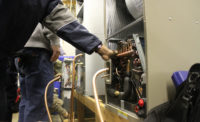When should contractors repair an aging HVAC unit and when should they suggest a full system replacement? The question has hounded the industry for decades. The NEWS recently spoke with a number of HVACR contractors, and, based on their responses, the question still lacks a definitive answer.
Life Expectancy
According to the National Association of Home Builders’ Study of Life Expectancy of Home Components, residential furnaces last an average of 15-20 years; heat pumps, 16 years; air conditioners, 10-15 years; and thermostats, 35 years.
Energy Star attempts to quantify the matter by providing a series of bullet points to determine when replacing a unit is the best option. It concludes replacement is necessary if: a heat pump or air conditioner is more than 10 years old, a furnace or boiler is more than 15 years old, equipment needs frequent repairs, energy bills are going up, a home has humidity problems, a home has excessive dust, or the heating and cooling system is noisy.
However, precise life expectancy is difficult to pinpoint due to numerous factors such as climate, usage, maintenance, rating, and more.
The staff at Walnut Creek Heating & Air Conditioning, Walnut Creek, California, estimates a unit that has been repaired more than twice in the last 10 years, is under a 13 SEER rating, or is 12-years-old or older should be replaced. On the opposite side of the coin, the company believes homeowners should consider a repair if the unit is properly sized, has experienced only minor issues, and can be repaired for less than half the cost of a full replacement.
“Consider replacement if the equipment is beyond three-quarters of its life expectancy and repairs will cost more than a third of replacement. So, if your furnace is 15 years old and you’re facing a $750 repair, you should probably replace the unit,” said Kevin Frump, general manager, Illiana Heating & Air Conditioning Inc., Cedar Lake, Indiana. “Keep in mind you can also take this opportunity to improve your home comfort and lower your utility bill. In other words, don’t just settle with a single-stage 80 percent efficiency furnace and be done with it — consider things like multiple staging, 95 percent efficiency, and variable-speed blowers to maximize your savings and comfort.”
Let the Customer Decide
Bill Brown, president, Paramount Heating & Air Conditioning LLC, Worthington, Ohio, believes that giving customers information and offering options is critically important. “Whenever possible, we always present repair options, regardless of the age of the system, overall condition, or repair amount,” he said. “We let the customer decide if they want to continue to invest in the equipment or replace it completely. If they ask, ‘How much is a new unit?’ after they’ve seen repair options, we will discuss replacement.”
Carter Stanfield, author of “Fundamentals of HVAC/R,” prefers to let the customer make the decision.
“It is largely an economic decision. Just be sure to include all the economic factors and not just the initial outlay,” said Stanfield. “You can often make a reasonable economic argument for replacing outdated equipment based on operating cost; so, if you are looking at an old 10 SEER unit or a standing pilot gas furnace, there is really no question that it is cheaper to replace it if you are including cost of operation for at least five years.”
Chris Leach, a partner with L&H Dynamic Business Solutions, Sarasota, Florida, suggests customers will often bring up the prospect of a replacement largely on their own.
“When does a contractor offer replacement? When he or she has fully explained all of the necessary repairs on the system as well shown the customer wear-and-tear items that will cost them over time,” said Leach. “Once the problems have been identified, the tech will then give the total cost of those repairs and, in most instances, if the cost is significant, the customer will ask the golden question: ‘How much does a new system cost?’
Cost Plays a Role
The prospective cost of a new system in comparison to the repairs of the existing unit is obviously an important aspect of the repair-versus-replace decision.
Craig Johnson, owner of Sturgi’s Heating & Air Conditioning, Kenner, Louisiana, referenced the $5,000 rule: “You take the age of the equipment and multiply that by the repair cost. If the number is more than $5,000, then you should consider replacement. This gives you a starting point to entertain a discussion,” he said.
Dave Hutchins, owner, Bay Area A/C, St. Petersburg, Florida, said indoor and outdoor coils and compressors rarely last 15-20 years. “The price of replacement parts has skyrocketed,” he said. “If a major component fails without the benefit of a 10-year warranty, the consumer might be faced with another major failure soon. Couple this with the [better] SEER they can buy today and it’s time to replace.”
After both pricing options are given, Brown simply asks, “What should we do?”
“This phrase typically gets a response from the customer within 30 seconds,” he said. “If they have questions or objections, those come out at this time very quickly.”
Work Smart and Sell Smart
“I think a contractor is charged with providing homeowners with both repair pricing and their experienced-based opinion on the system,” said John Haley III, director of HVAC programs, Ferrandino & Son Inc., Philadelphia. “When a residential system reaches 10-12 years of age, there are many advantages to at least looking into the idea of replacement if a major repair presents itself. As residential systems increase in efficiency, the discussion is much easier and advantageous for homeowners, especially if they plan on being in the home for the long haul.”
Consumers can even surf the Web to learn about the potential savings a replacement may provide. One such tool is www.hvacopcost.com, which allows a homeowner to insert the age, size, and efficiency of existing equipment, where they live, and possible system replacement options.
While there may never be a singular answer on when it is time to replace an HVAC unit instead of repair it, Marc Newman, owner, Standard Refrigerators Inc., Long Island, New York, believes the decision will always come down to contractors doing their best work.
“Work smart and sell smart,” said Newman. “Gain customer trust by providing outstanding service and maintenance and then give a customer all the options with your recommendation. Don’t wait for the next guy to beat your price by a few dollars. If you are doing the job right, the customer will hear you and use you. There are all kinds of financing options available that can make the energy savings available to someone who can’t afford the work at this time. A good mechanic uses all his tools to do a professional job. We [as contractors] should do no less.”
Publication date: 10/27/2014
Want more HVAC industry news and information? Join The NEWS on Facebook, Twitter, and LinkedIn today!











